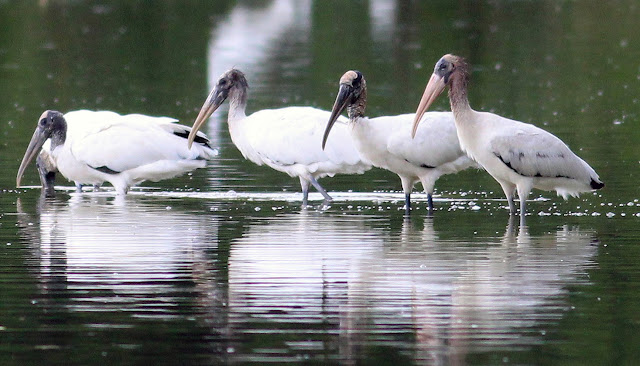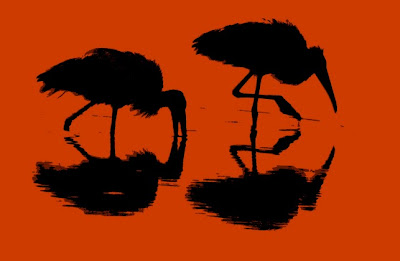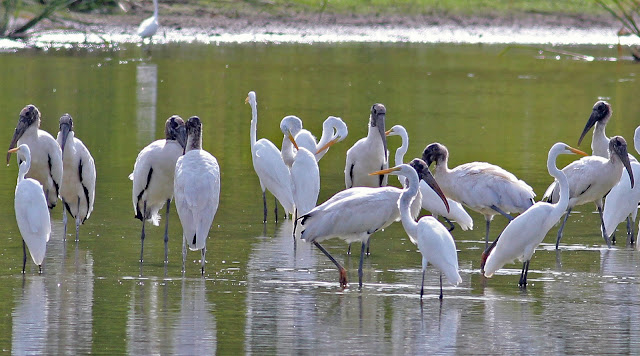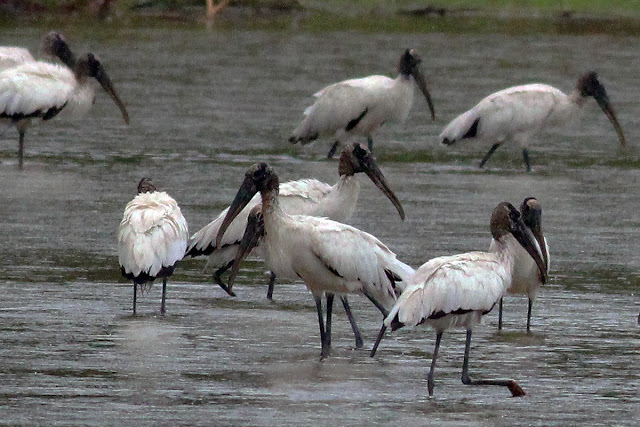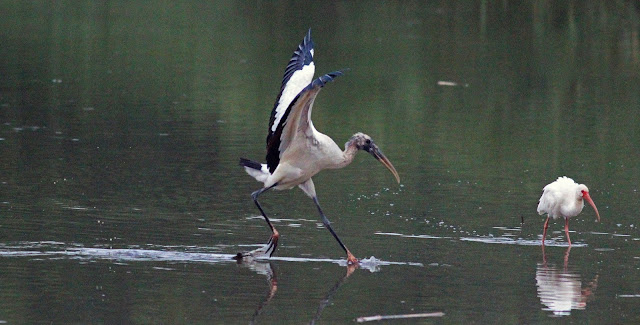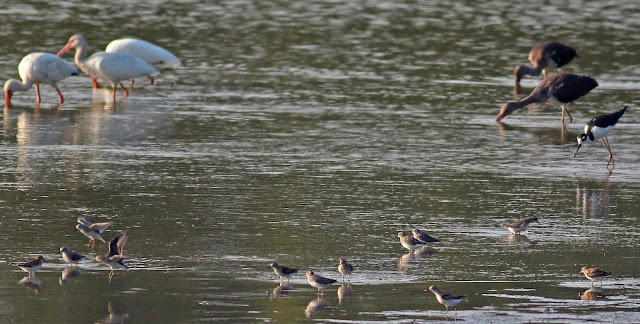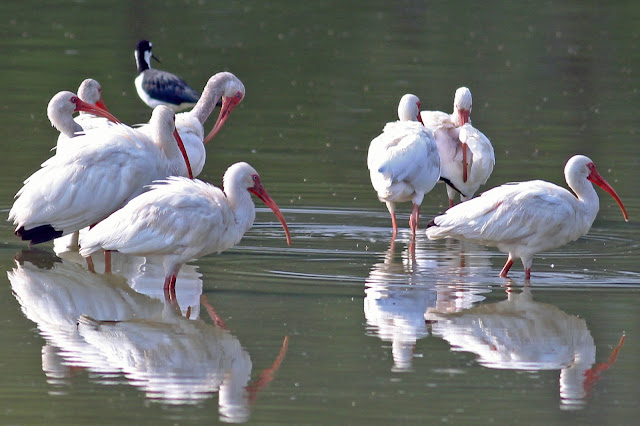Wood Storks On The Rebound — The Rare Species Returns To The Great Trinity Forest
 |
| Wood Storks in Dallas, Texas, photo taken by James Cartwright, August 1936 |
Some seventy seven years ago, a man named James “Jim” Cartwright took a small camera out fishing with him to an old bow on the Trinity River turned fishing club named Lemmon Lake. Out there one afternoon he took a photo of some strange looking birds that had flown in and were milling about on the grassy shore. Wood Storks. Late last year one of his descended relatives contacted me and I was given some of his old fishing photos from the lake. My interest gravitated to one photo in particular an old scratchy Wood Stork photo dated “August ’36 Rod and Gun”. That particular bird species in the next few decades would see its very population dwindle to almost nothing and faced the very real threat of extinction.
 |
| Wood Storks at Little Lemmon Lake, Joppa Preserve, Great Trinity Forest, Dallas, Texas August 2013 |
The 97th Meridian slices through North Texas as an imaginary line that exists only on drawn maps. In this locale, that line serves as a freeze/frost line in the winter separating brutal cold from the mild. In the fall the line is marked by great fall foliage to the east and barren brown to the west. In the spring, the great powerful fronts and dry lines rip off the plains to form thunderstorms.
During the summer, the 97th serves as an avian boundary of sorts for many wading birds that are common to the east and rarely if ever seen to the west. This is the time of year when the faint glow of a setting sun is oft punctuated behind the crests of ever rising thunderheads in the distance. In late summer 2013 as the seabreeze laden winds of the Gulf meet the hot winds off West Texas plains, the birds of the tropics find themselves at home in the Great Trinity Forest. The photos shown here were taken in late summer in a couple evenings when the weather quickly turned from sun to clouds to heavy storms and back to clear skies again.
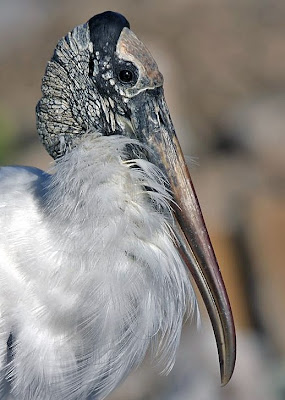 I suppose it comes as a surprise to many that a bird of as rare a feather like the Wood Stork plans a summer vacation stay inside the city limits of Dallas. The record books of sightings of the species in our fair city draw a blank as to the migration of the bird. Not for lack of birds but for lack of perhaps sets of human eyes on the watch for them.
I suppose it comes as a surprise to many that a bird of as rare a feather like the Wood Stork plans a summer vacation stay inside the city limits of Dallas. The record books of sightings of the species in our fair city draw a blank as to the migration of the bird. Not for lack of birds but for lack of perhaps sets of human eyes on the watch for them.
The Great Trinity Forest with its patchwork of wetlands and shallow ponds provides ideal habitat for wading birds. Just perfect. One such place known to attract such birds over the past few years is Joppa Preserve located south of Loop 12 and along the west bank of the Trinity River.
The wildlife laden areas of Joppa Preserve by modern standards is still difficult and remote to reach. The standard first time approach to the place is to clumsily step off the pavement into a mass of greenbriar thicket and poison ivy wondering if you will ever return. With the reward of remoteness to such a place comes the understanding that self-reliance is cornerstone of the visitor experience.
It’s the gift of knowledge that surrounds this place. The deep hidden history of a spot. It seems that Dallas only offers parks with less adventure, no aura and no exploration, a quality of it’s presence diminished is the product as a result. Joppa Preserve is not a cookie cutter park. It stands alone as one of the last great wild areas of North Texas.
The Wood Storks seen here in Joppa Preserve hail from the Mexican state of Campeche, western Guatemala and points south from there into the Amazon. They fly to Dallas as part of “dispersal” which occurs after their young have finished nesting. They leave the coast and head inland in search of habitat and food.
Wood Stork (Mycteria americana)
Wood storks (Mycteria americana) are large water birds that stand 2-4 feet tall and are the only stork in North America. They have wingspans as wide as 5 1/2 feet. They are mostly white, but have a black tail and many black feathers under their wings. Storks are related to ibises, herons and flamingos. They have no feathers on their head and neck, so the black skin underneath shows. This makes wood storks the only tall water birds with black, bald heads. Since they have no muscles attached to their voice box, they are very quiet birds.
Wood storks use the massive beak as their source of food gathering. The feed in water no deeper than their beak and catch a variety of things in their bill which they then toss their head back and swallow. This technique is known as “grope feeding”. This because the stork does not use vision in food collection, but instead does everything by touch. The reflex of the bill after it touches food is thought to be the fast of any reflex in the vertebrate world. When it feels a fish, the stork can snap its bill shut in as little as 20 milliseconds—an incredibly quick reaction time.
 |
Below is a video clip shot in August 2013 of a Wood Stork flock working the middle of Little Lemmon Lake for prey
Their diet has been known to consist of fish, crayfish, salamanders, tadpoles, shrimp, frogs, insects and an occasional snake. Storks also use their feet to stir the bottom when collecting prey. This technique startles the food from the vegetation into the beak. Some think that the water turbulence caused by this action simulates the water movement of a feeding frenzy, and can attract fish to become prey.
Wood Storks were once hunted for their feathers and have also lost much of their habitat to swamp draining in Florida. In Texas, the Wood Storks migrate north in the early summer from Mexico to take advantage of drying lake beds and the abundance of fish found in them. There have been only a handful of sightings in the DFW area of Wood Storks. Joppa Preserve is special in that so many can be seen at one time. Wood Stork sightings are more numerous further to the south in the Houston and Corpus Christi areas where the habitat lends itself to Wood Stork feeding tactics.
A Threatened Species
 |
In late 2012 Endangered Species Status for Wood Storks was downgraded to Threatened in the United States. The birds are given a statewide “Threatened” status in Texas. The Endangered listing applied to Wood Storks who live and breed east of the Mississippi in the Deep South and Florida. Wood Storks are still afforded the protections of Federal Threatened Status here in Texas but since they do not breed here they are given a lesser designation.
Passed in 1973 and reauthorized in 1988, the Endangered Species Act regulates a wide range of activities affecting plants and animals designated as endangered or threatened. By definition, endangered species is an animal or plant listed by regulation as being in danger of extinction. A threatened species is any animal or plant that is likely to become endangered within the foreseeable future. A species must be listed in the Federal Register as endangered or threatened for the provisions of the act to apply. The Act prohibits the following activities involving endangered species:
-Importing into or exporting from the United States.
-Taking (includes harassing, harming, pursuing, hunting, shooting, wounding, trapping, killing, capturing, or collecting) within the United States and its territorial seas.
-Taking on the high seas.
– Possessing, selling, delivering, carrying, transporting, or shipping any such species unlawfully taken within the United States or on the high seas.
-Delivering, receiving, carrying, transporting, or shipping in interstate or foreign commerce in the course of a commercial activity.
-Selling or offering for sale in interstate or foreign commerce
The United States breeding population of the Wood Stork declined from 20,000 pairs in the 1930’s to about 10,000 pairs by 1965, and to a low of approximately 5,000 pairs in the mid 1970s. Nesting primarily occurred in the Florida Everglades. The accepted explanation for the decline of the Wood Stork is the reduction of small fish necessary to support breeding colonies. This population reduction is attributed to loss of wetland habitat as well as to changes in water hydrology from draining wetlands and changing water flow by constructing canals, levees and gates to alter water routing in southern portions of the United States.
 |
| Juvenile Wood Storks seen with tan-yellowish bills |
Wood storks have a unique feeding technique and require higher fish concentrations than other wading birds. Optimal water conditions for the Wood Stork involve periods of flooding, during which prey (fish) populations increase, alternating with drier periods, during which receding water levels concentrate fish at higher densities coinciding with the stork’s nesting season.
This year it was rather interesting to see young Wood Storks in large numbers at Little Lemmon Lake. The young birds can be easily spotted by their yellowish-tan light colored beaks.
The Wood Stork , Bald Eagle and many other species of migratory birds owe their current existence in the United States to the determined, last-ditch efforts carried out under this legislative milestone. But attempting to pull species back from the brink of extinction can be an expensive and contentious proposition. Even today, despite considerable conservation gains in the past few years, many challenges still threaten to drive species away from healthy populations, and onto the endangered species list.
The past half century has borne witness to dramatic changes in the quality and quantity of wildlife habitat. Throughout the United States, Mexico and South America, wetlands continue to be drained and filled, forests cut and fragmented, and grasslands developed for home construction. Many of these changes are not what they appear. While forest and woodland cover in some areas has actually increased, the quality of those habitats compared to the original woodlands may not be similar at all because of changes in vegetation composition and artificially abundant predator populations. Other less intrusive land use practices have upset the natural balance as well.
As any ornthological minded person knows, some species are exceptionally rare, some are fairly common, and some can be found on almost any visit to the field. The differences one sees in species abundance occur naturally. Natural events, like weather, predators, disease, and food and habitat availability, have shaped these patterns of species abundance for many centuries. In recent years, however, human activities have disrupted many of those natural events, resulting in a change in the shape of the environment. No place has seen more of that than the Trinity River.
The Trinity River As A Wildlife Highway
Wildlife, both fleet footed and on the fly, use the Trinity River as a main artery of travel from the parched uplands northwest of Fort Worth, clear to Trinity Bay on the Gulf of Mexico. It has likely been that way for hundreds of thousands of years, a route implanted upon the DNA of the species who frequent the river. Wood Storks are most likely no exception to that process.
 |
| Wood Storks at Little Lemmon Lake during a heavy thunderstorm |
For continued survival of the United States population of wood storks, currently occupied habitat, roosting, and foraging environments must be protected from further loss or degradation. A prerequisite for complete recovery of the population is the restoration and enhancement of suitable habitat throughout the variety of environments used by this species.
The very survival of the Wood Stork runs through places like Joppa Preserve and the Great Trinity Forest. An unlikely point of concern as so few people alive even know it exists. It has not been much of a going concern since the old Trinity Rod and Gun Club days when Jim Cartwright drowned worms here in the 1930s. Times change though and so do plans for development.
Little Lemmon Lake and Lemmon Lake are but just two of the dozen small ponds and marsh wetland areas in the Great Trinity Forest that give these wading birds forage area for food and habitat. There is grave concern at the moment that the dozen or so water bodies across the Trinity River to the east near the Trinity River Audubon Center will be impacted by a new planned golf course called the Trinity Forest Golf Course.
The AT&T Trail Construction, Habitat Loss For The Wood Stork?
The AT&T Trail construction starts very soon, a concrete trail that will traverse one of the only undeveloped parcels of virgin hardwood bottomland left inside the city limits. It will also cut along the southern bank of “Pond T”, what the friendly folks at the Audubon Center call the “Secret Pond”. This pond serves as a virtual refuge for dozens of species of not just birds but river otters, beavers and deer. The impact of a new trail will degrade this special spot and have a negative impact on foraging Wood Storks.
 |
| Pond T, aka the “Secret Pond” which is one of many pocket ponds and lakes in the Great Trinity Forest |
 It seems odd that a place like Dallas would be such a touchstone for the survival of the Wood Stork. These old ponds are just the ideal habitat for them and every year more and more make their way up from the south. How can a trail be built in this area or a golf course developed without impacting the Wood Stork is an answer no one seems to have.
It seems odd that a place like Dallas would be such a touchstone for the survival of the Wood Stork. These old ponds are just the ideal habitat for them and every year more and more make their way up from the south. How can a trail be built in this area or a golf course developed without impacting the Wood Stork is an answer no one seems to have.
If we use Little Lemmon Lake as an example, the hydrology of such a water body is really unique inside the city limits. The lake sits just low enough so that the annual flooding events of the nearby Trinity River “overbank” into Little Lemmon. The fish, fry and aquatic life from the river regenerate the dry lakebed and transform it from a playa into a small lake teeming with life. As the weather dries and the punishing Texas sun works on evaporating the lake, wading birds flock in by the hundreds.
These are not the birds one might see at White Rock Lake. Sure intermixed are some Great Egrets, a few Herons but the other species are eye popping in diversity. Not seen anywhere else inside the city limits.
Most would stand jaw agape at seeing a Wood Stork ski in to visit with a flock of White Ibis. Just seeing the White Ibis for many would be a treat, watching a Wood Stork interact with them makes it so much more special.
Maybe the problem with the place is no one can take credit for what is going on here. No one can stand on a soapbox and say they are responsible for the habitat here or have somehow enhanced it to attract such wild birds. A freak of a natural place that the hand of man never had anything to do with. Imagine that.
Here the shorebirds, Sandpipers, work the mudflats along the shore with Black-Necked Stilts and Ibis beyond.
 |
| Two juvenile White Ibis center, two adult White Ibis on the margins at Little Lemmon Lake |
 |
| Sandpipers in flight at Little Lemmon Lake |
 Take for instance the adult Black-Necked Stilt, Himantopus (mexicanus) mexicanus. Males and females are nearly indistinguishable, although the plumage on the backs of some females can be more brown than black in color. Stilts are remarkable because their legs are longer in proportion to their bodies than those of any other bird species except the flamingo. The North American black-necked stilt is distinguished from the European black-winged stilt by the white spot above its eye.
Take for instance the adult Black-Necked Stilt, Himantopus (mexicanus) mexicanus. Males and females are nearly indistinguishable, although the plumage on the backs of some females can be more brown than black in color. Stilts are remarkable because their legs are longer in proportion to their bodies than those of any other bird species except the flamingo. The North American black-necked stilt is distinguished from the European black-winged stilt by the white spot above its eye.
Don’t see too many of these in Dallas, they often stick to flocks of other species, attracted to the very shallow water so many of them prefer.
Many of the birds here are fresh off the saltwater flats and coasts to the south. On occasion in the right light, the White Ibis can take on a pinkish shade of white, a hue, from the high amounts of saltwater crustaceans they consumed in the weeks before.
 |
| Wood Storks, Neotropic Cormorants and a Snowy Egret at Little Lemmon Lake |
Hanging on by a fragile thread, the rare places left inside the city limits of Dallas that attract such wildlife seem to be in real peril from planned development. These smallish ponds and drying beds are the real endangered species of note. Oh so rare and important to so many species of birds, the world over, who seek out the water here for habitat. It would be a tremendous loss to the city as a whole, we would all be poorer for it, if the planned development here impacted the wildlife in any way.
 |
| Little Lemmon Lake as the storms clear after an evening thunderstorm |

